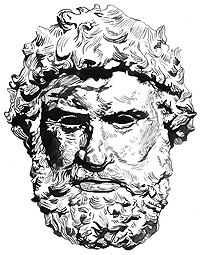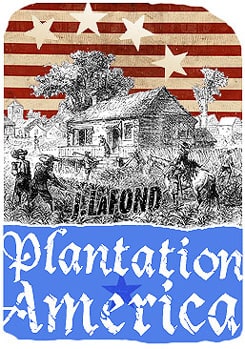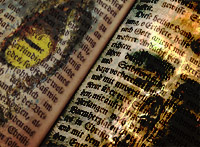Gibbon continues his recitation of the woes of Roman governance as a study in monarchy while weaving in the emerging stories of those tribes that drew away “the veil” of Roman power and exposed its weakness as well as its great storehouses of wealth, many densely populated cities. These cities were being beset by disease, although this occupies a minor thread. The 20 years from 248 thru 268 that occupy Chapter 10 were shameful “to the imperial power,” above all else. The army, which was needed to combat barbarian invasions, had murdered so many princes, had forced generals to “take the purple” or be killed, that to their lack of “constitutional principles” and patriotism, was now added a lack of attachment to those usurpers they elevated.
“For the first time their emperor fled in disorder before a horde of half-armed barbarians,” referring to a disaster suffered by Decius, one of the ill-fated emperors of these sad 20 years, during which the head of state was merely a military governor of the borderland.
“While Decius was struggling with the tempest,” and trying to restore the “majesty of the laws.” This man attempted to revive the “obsolete office of Censor,” who The Senate chose, being Valerian, who would become one of the few “Good Emperors,” of the time “between Augustus and Diocletian.” The Censor was to restructure the state and culture and would have power over all but three people in the Empire, [1] which Decius was trying to return to a republic. His was a hopeless cause, as decadence had set so deeply in that there was no moral material to be worked into a revived body politic. Valerian would serve loyally until he had the occasion of avenging his slain master, Decius.
“A censor may maintain, he may never restore,” the morals of a state declares Gibbon, in another moment of civic clarity.
“It was easier to vanquish the Goths than to repair” the morals of the nation that “was sunk so deep into corruption.”
“The high-spirited barbarians preferred death to slavery!”
“The combat was terrible. It was the combat of despair against grief and rage,” is how Gibbon charts the battle that slew the son of Decius and left the body of Decius un-recovered in a terrible morass.
“Such was the fate of Decius, in the fiftieth year of his age,” is an example of the honor Gibbon gives to the ancients cast into Eternity in attempts to do good for the common cause. Edward supplies meaningful epigrams for the fallen men who died in service to “humanity.”
Valerian will be further honored by being described as the man “who Humanity would have chosen as their master,” had humanity a choice in the matter. Gibbon had the great wisdom of knowing that even democrats did not choose their masters.
In Chapter 9, Gibbon squarely declares that civilization is an agreement on the part of most folks to suffer slavery in return for a surer supply of food, shelter and order. What he charts in Chapter 10 is an all out war of barbarism versus civilization.
The infamy of the peace was more deeply,” felt by the corrupt Romans than the reversals of war. The People did not deserve even the flawed masters that they were granted by Fate. Indeed, the sleazy, slavish Romans seem to have deserved what they got, Barbarian Invasions. The murder of emperors by soldiers, the mistrust of all factions by all, made of Rome a doomed ship of state sailing into a stormy night.
“Less than four months intervened between his victory and his fall,” notes Gibbon of Amelianus, who did away with a sleazy emperor, only to be bested by Valerian, the squarest civil servant of the age. Valerian was a 60 year old man, who devoted his life to preserving The State and was the declared “enemy of Tyrants.” Alas, Valerian could not succeed in doing more than slowing the advance of the barbarians and could do nothing to repair the deranged decadence of his fellows. Valerian was not able to rise above the age, despite being its best man, elevating his decadent and feminine son to co-emperor.
The most dangerous enemies of Rome during this 20 year period of infamy were:
-1. The Franks formed in about the year A.D. 240, as a confederacy of tribes from Lower Germany. Franks meant “freemen.” These men crossed the Rhine, and the Pyrrennes and ravaged Spain and North Africa. Nowhere does Gibbon describe these races as “white,” as men born towards the end of his life would begin referred to Europeans. They are granted a “complexion” that was regarded as striking by North Africans.
-2. The Alimani, were a mix of Germanic tribes known for being horsemen, which gives an appreciation for the open nature of the old growth Hersinian Forest. The Swavians, who sacrificed humans in their sacred groves, as true Odinists would, wore topknots like Eastern Woodland Indians and were the most feared of the Alimani. The Marcomani were one of the Swavic tribes.
-3. The Goths, Odin fanatics, in three tribes, Ostragoths [eastern], Visagoths [western] and Gepedi [loiterers], came from Sweden and had short swords and round shields. Their iron was had through their trade in Amber. The Goths got around the Black and Aegean Seas by the expedient of enslaving local men and using them as “pressed sailors,” “The robust youth of the coast were chained to the oar.” One city had 100,000 slain in a night. The garrison of Calcedon outnumbered the invaders and deserted their post. A perfidious fugitive,” acted as a Gothic guide “the Goths had learned sufficient policy to reward the traitor who they detested.” The deserting soldiers, the traitor guides, the moral rot of the sleaziest slave civilization of antiquity, saw dozens of cities that were richer than the imperial capitals of earlier empires, perish, with the Goths serving as the widest ranging authors of this retribution.
-4. The Persians, treated in Chapter 8. That was the fourth front, a rival civilization.
“Hovered” and “infested” are terms used by Gibbon to describe these free peoples as a scourge upon civilization. He does note that despite the Ukraine being a land that naturally beckons man’s “industry,” that the Goths did not improve it and that the land in his day yet looked the same, “in a state of nature,” as the Cossacks lived like the ancient Goths, as “free soldiers, almost savages.” Despite the energy, “valor,” tenacity and willingness to risk all in a desperate gamble of their own lives, so long as competent military governor was on duty at a given seaside city, they could not take the place. But a place such as Trebizond, with a huge garrison and great walls, was easily taken as the garrison refused to fight.
The Franks, Alimani and Goths were not just plundering tribes of opportunists, but honor cult confederations operating with the conscious aim of eradicating Civilization itself. If not for the infiltration of Christianity, down stream from this happy 20 years of burning slave cities, the Germans might have succeeded in carrying Odin’s torch down through the ages and bringing back the sacred ways of the forest warrior.
Feudalism would be the resulting compromise between this barbaric revolt against the moral rot of Civilization and Christianity with its sacrificial civility.
Notes
-1. Including the Eldest Vestal Virgin, prototype of the nun.











